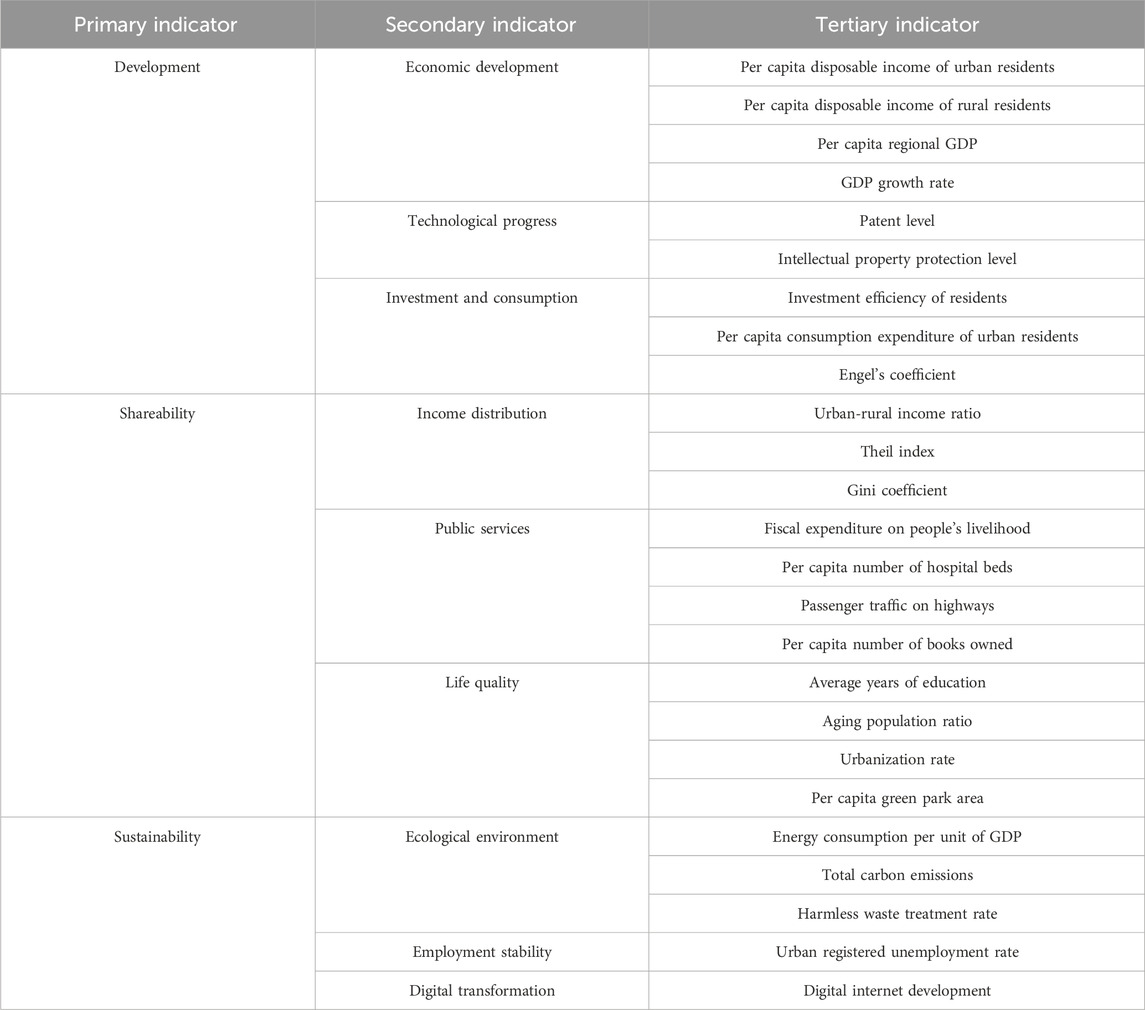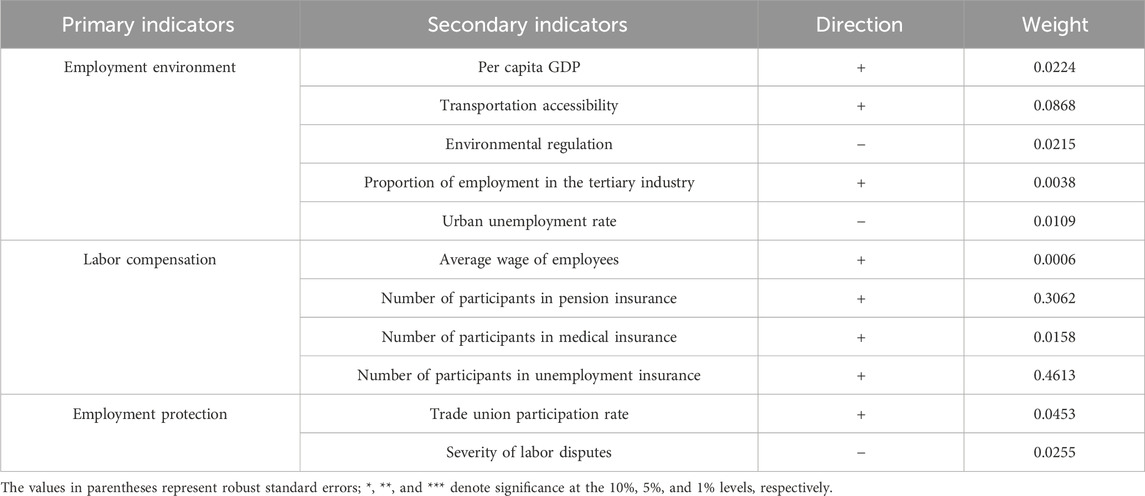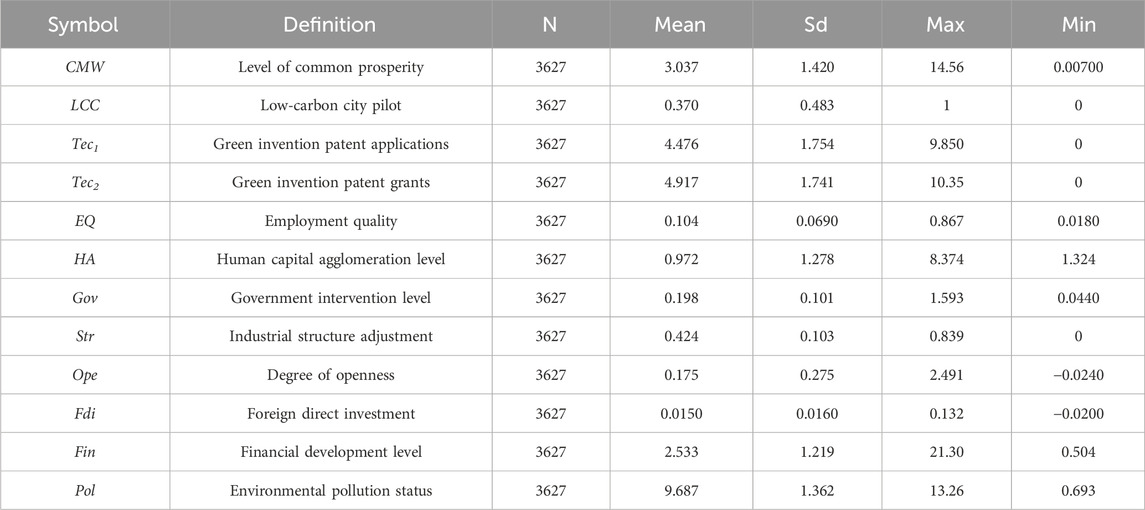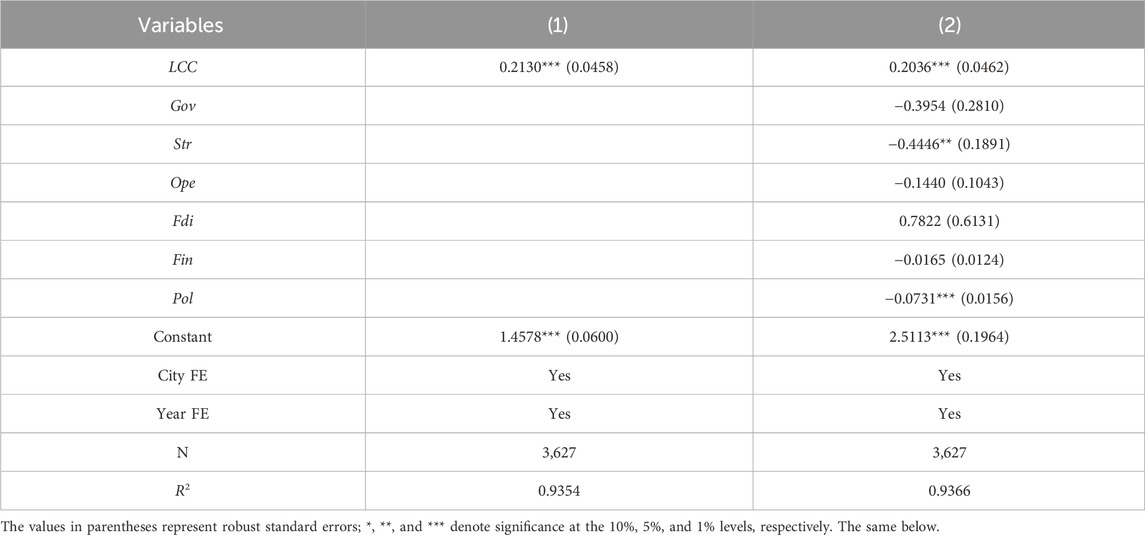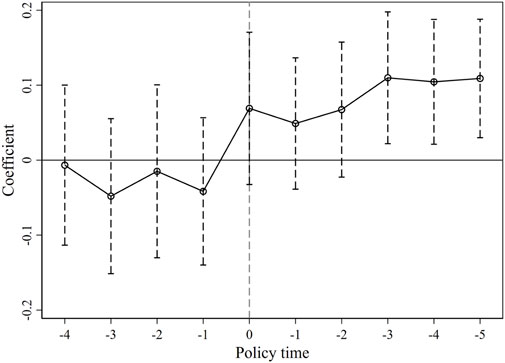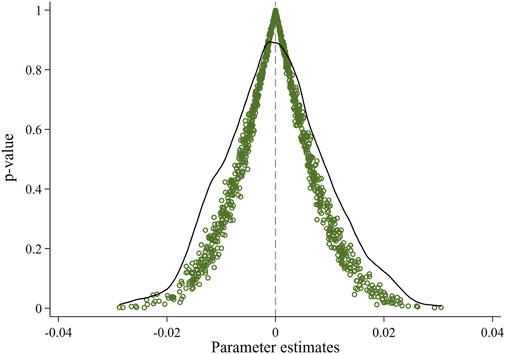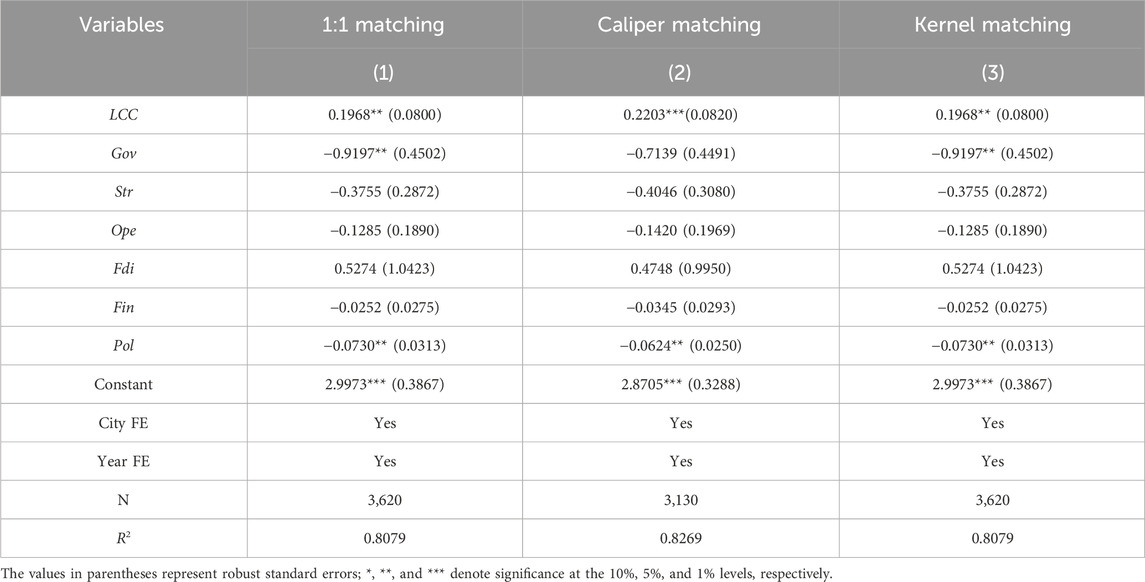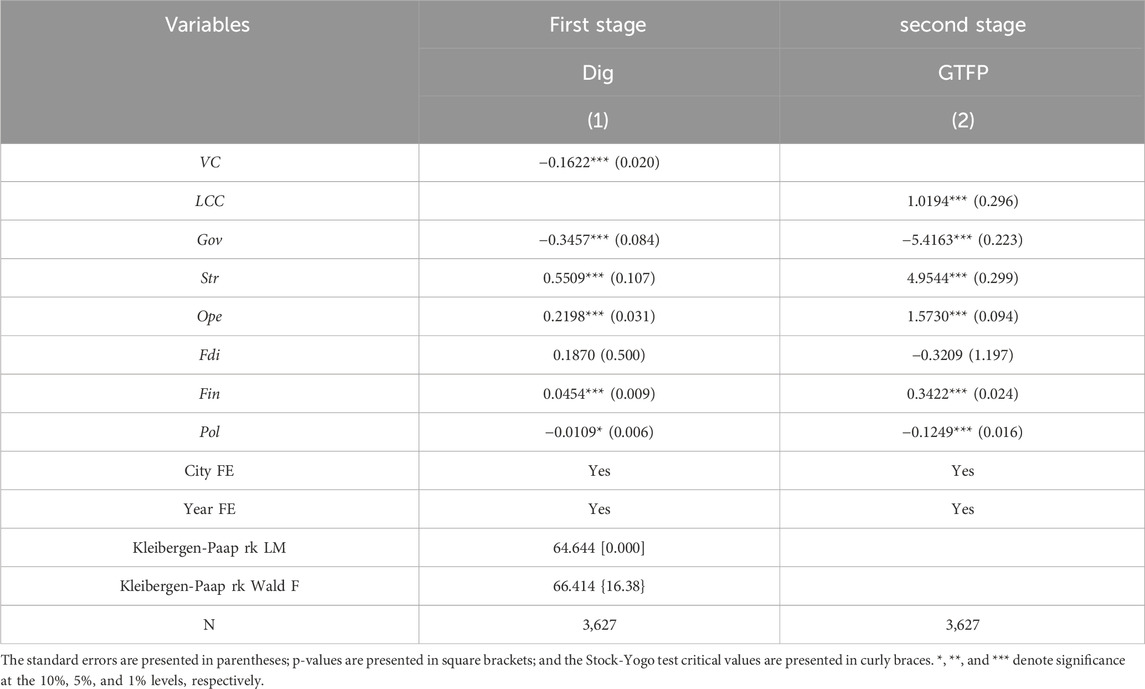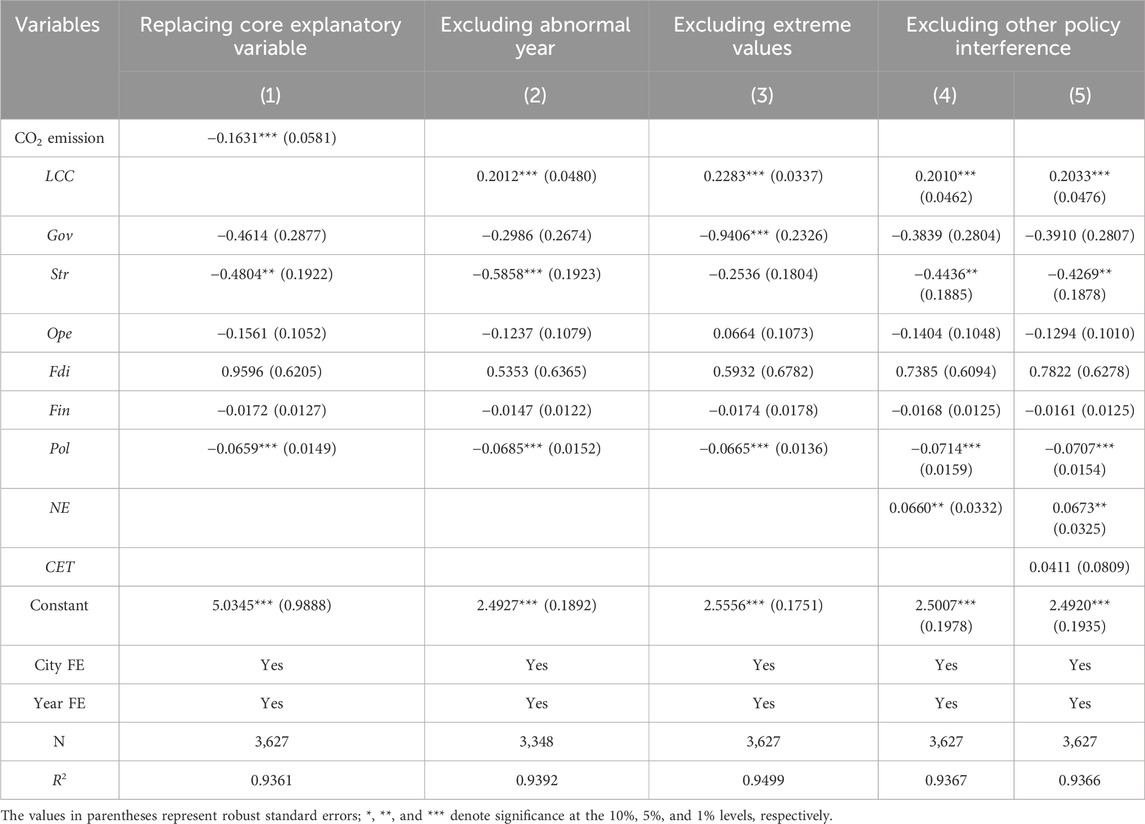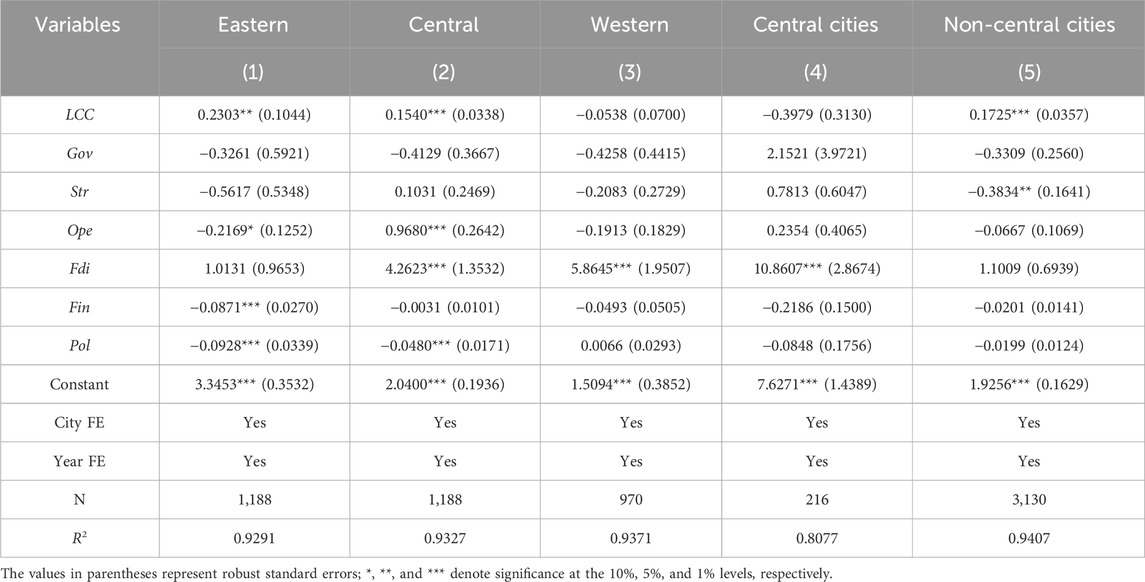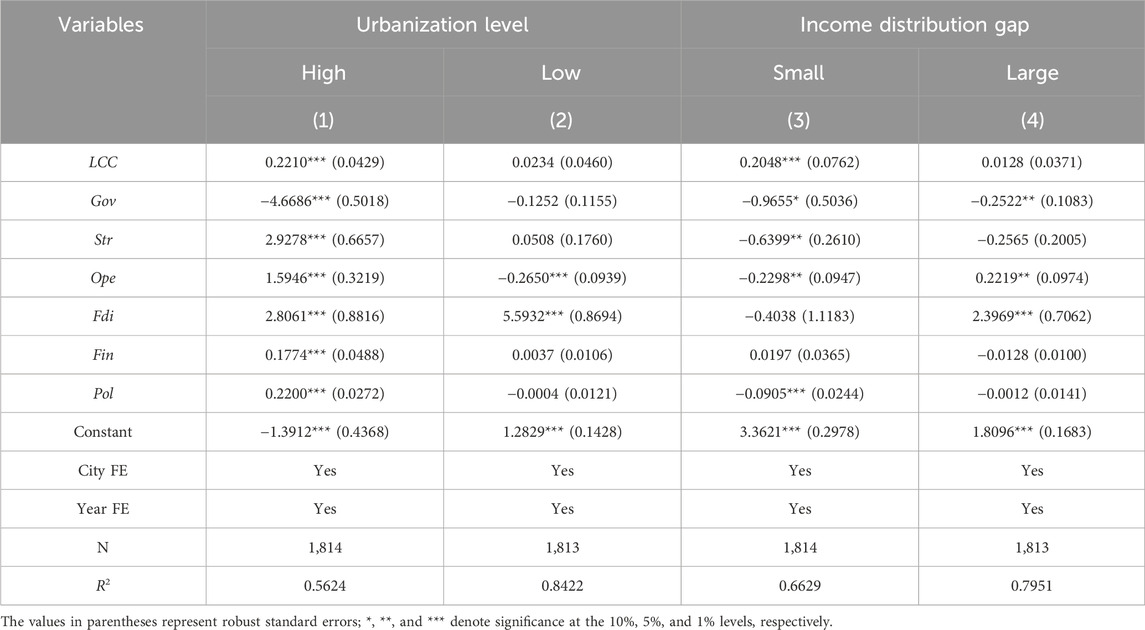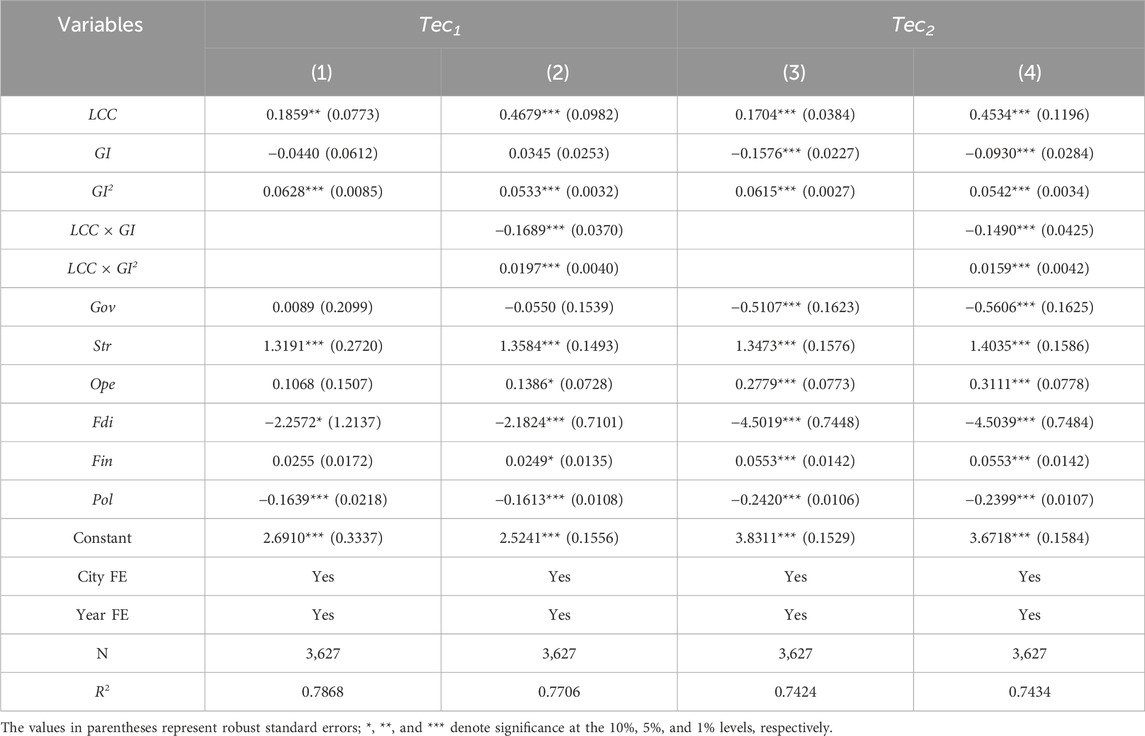- School of Economics, Shandong Normal University, Jinan, China
Introduction: Green and low-carbon development is a fundamental pathway to modernization and a critical driver of common prosperity. Using panel data from 279 prefecture-level cities in China from 2010 to 2022, this study empirically examines the impact of low-carbon city pilot policies on common prosperity and their underlying mechanisms.
Methods: Common prosperity is measured using principal component analysis, and a staggered difference-in-differences model is applied for empirical analysis. Robustness is verified through parallel trend test, placebo test, propensity score matching difference-in-differences, instrumental variable estimation, etc. Additionally, a moderation model is used to examine the U-shaped moderating effect of green technological innovation on the relationship between low-carbon transition and common prosperity.
Results: The implementation of low-carbon city pilot policies significantly promotes common prosperity, this result remained robust in multiple robustness tests, and this effect exhibits a time lag. Green technological innovation plays a U-shaped moderating role in the relationship between low-carbon city pilot policies and common prosperity. Low-carbon city pilot policies contribute to common prosperity by enhancing employment quality and fostering human capital agglomeration. The positive effects of low-carbon city pilot policies are more significant in eastern and central regions, non-central cities, cities with lower urbanization levels, and cities with smaller income distribution gap.
Discussion: Based on the findings, this study recommends advancing low-carbon city pilot policies through region-specific strategies, promoting green innovation and high-quality employment, and fostering human capital development through targeted support measures. Furthermore, it is essential to establish dynamic policy evaluation and adjustment mechanisms, while strengthening interregional cooperation and ensuring equitable labor mobility, to achieve the coordinated progress of urban green transformation and common prosperity.
1 Introduction
The pursuit of sustainable development has become a critical global priority in response to escalating environmental crises, widening economic disparities, and the need for long-term social stability. At the core of this agenda lies the concept of common prosperity, which emphasizes not only economic growth (Zou et al., 2024) but also equitable income distribution (Liu et al., 2017; Zhou et al., 2024) and environmental sustainability (Ma and Ma, 2024). A sustainable development model that fails to address social inclusiveness and economic fairness risks exacerbating inequality and undermining social stability. While economic progress has lifted millions out of poverty, persistent disparities in wealth, resource accessibility, and regional development pose significant challenges to achieving balanced and resilient prosperity.
Against this backdrop, transitioning to a low-carbon economy presents a promising pathway for harmonizing economic development with social equity and environmental responsibility (Sievers et al., 2019). On the one hand, low-carbon transition can drive green technological innovation, improve energy efficiency, and promote industrial upgrading, thereby achieving high-quality economic growth. On the other hand, by developing emerging industries, creating employment opportunities, and enhancing labor productivity, it fosters social equity. Additionally, low-carbon transition can alleviate environmental pollution (Sun et al., 2024), improve public health, and thus promote the realization of common prosperity. In this process, low-carbon city pilot policies, as representative low-carbon transition policies, demonstrate their significant role in advancing common prosperity by promoting green technological innovation, industrial upgrading, and employment improvement. Although low-carbon city pilot policies are considered an effective means to achieve common prosperity, there are still numerous challenges in their implementation. Firstly, inefficiencies in regulation may hinder the effective execution of low-carbon policies. Secondly, regional economic structural differences create substantial resistance in some areas to the implementation of low-carbon policies. Moreover, the implementation of low-carbon policies is often accompanied by certain economic trade-offs, with some high-carbon industries facing significant economic costs in the short term. Finally, in some cases, low-carbon policies may lead to unintended consequences, such as exacerbating regional development disparities. Therefore, whether low-carbon city pilot policies can truly promote common prosperity remains an important question that requires further exploration. Some literature suggests that low-carbon policies may lead to large-scale layoffs in energy-intensive and high-emission industries, which could hinder social equity and thus obstruct the realization of common prosperity (Ferris et al., 2014). Other studies argue that the trend of low-carbon policies may promote the development of clean industries, thereby creating new job opportunities and contributing to a more equitable distribution of economic benefits (Xu and Li, 2023). However, existing literature has not fully addressed the specific role of low-carbon city pilot policies in promoting common prosperity. Furthermore, if low-carbon transformation can indeed promote common prosperity, what are the specific mechanisms through which this effect occurs? This issue also needs to be further explored.
To address these issues, this paper utilizes panel data from 279 prefecture-level cities and treats the implementation of low-carbon city pilot policies as a quasi-natural experiment. The staggered difference-in-differences (staggered DID) method is applied to assess the direct impact of these policies on common prosperity. Based on this, the paper further analyzes the heterogeneity of this effect to determine whether low-carbon policies disproportionately benefit certain regions. Additionally, the paper explores the moderating effect of green technological innovation, as well as the mediating channels of improvements in employment quality and human capital accumulation. Finally, corresponding policy recommendations are proposed based on the research findings, providing theoretical support and practical guidance for optimizing the design of low-carbon policies.
2 Literature review
The implementation of low-carbon city pilot policies in China began in 2010 with pilot initiatives in five provinces—Guangdong, Liaoning, Hubei, Shaanxi, and Yunnan—and eight cities such as Tianjin and Chongqing. 2 years later, in 2012, the second batch of pilot projects was set in motion, involving 29 provinces and municipalities including Beijing and Shanghai. In 2017, the third batch of low-carbon city pilot undertakings was earmarked for implementation in 45 cities (districts, counties), with Wuhai City in the Inner Mongolia Autonomous Region among them. The existing literature on the effects of low-carbon city pilot policies primarily focuses on three aspects: environmental benefits, economic impacts, and innovation incentives. Environmental benefits, as the fundamental outcomes of policy implementation, have reached a scholarly consensus, with studies indicating that low-carbon city pilot policies significantly improve ecological conditions, including reducing carbon emissions and air pollution (Cao et al., 2025). The accumulation of environmental governance outcomes triggers the emergence of economic effects, which display a clear hierarchical characteristic. At the urban level, pilot policies promote the transformation of economic growth models through restructuring employment and cultivating green industries (Zhuang, 2020). This is reflected in the increased labor absorption capacity of industries such as new energy and energy conservation, as well as the rising share of green GDP (Song et al., 2021; Cui et al., 2021). From an inter-city perspective, these policies have driven the growth of green product exports and price optimization, thereby enhancing the international competitiveness of green products (Ling et al., 2024). Against the dual backdrop of environmental benefits laying the ecological foundation and economic impacts showcasing transformation outcomes, the dimension of innovation incentives reveals the deeper driving mechanisms of the policy’s effects. The implementation of low-carbon city pilot policies has been found to significantly stimulate green technological innovation (Wan et al., 2024). This effect is primarily achieved through the promotion of industrial restructuring and upgrading (Zou et al., 2022; Li et al., 2023) as well as improvements in total factor productivity (Chen et al., 2021).
Scholars have extensively explored the pathways to achieving common prosperity, emphasizing the necessity of balancing development, inclusiveness, and sustainability (Phillips, 2005). First, development. Achieving common prosperity requires addressing issues of unbalanced and inadequate development to ensure that all individuals have equal opportunities to accumulate human capital and participate in collective wealth creation (Lutfi et al., 2021). Hwang and Park (2023) emphasized the importance of real economic growth, advocating for the financial sector to serve the real economy, thereby enhancing financial wellbeing through financial development to promote common prosperity. Alonso-Carrera and Raurich (2018) stressed the revitalization of the collective economy and the need to increase labor income shares as key measures in achieving this goal. This aligns with the practice of low-carbon city pilot policies. Low-carbon policies promote the development of green industries, enhance industrial inclusivity, and provide equal development opportunities to a broader population, thus facilitating economic transformation and the realization of common prosperity (Chen and Wei, 2024). Second, inclusiveness. Existing studies indicate that reforming the income distribution system (Alyakoob and Rahman, 2022) and equalizing access to basic public services play crucial roles in promoting common prosperity. Bao and Lu (2020) argued that the comprehensive use of the first, second, and third income distribution mechanisms can help narrow regional, urban-rural, and income disparities. Luo and Yan (2025) further suggested that tax incentives and policy adjustments can encourage participation in tertiary distribution, thereby reducing income inequality. Under the framework of low-carbon policies, redistribution mechanisms such as fiscal transfers to ecologically vulnerable regions also contribute to achieving inclusive sharing (Finon, 2019). Third, sustainability. Yao et al. (2023) suggested that the carbon emissions trading system, through the dual mechanism of government regulatory pressure driving enterprises to fulfill environmental responsibilities and promoting clean innovation to enhance green technologies, provides a micro-level pathway for the synergetic achievement of low-carbon development and common prosperity sustainability. Zhang J. et al. (2024) found that digital literacy, through its dual mechanism of increasing household income and reducing relative poverty, promotes rural common prosperity, offering a technological empowerment pathway for sustainable rural development. In the practice of low-carbon policies, the carbon emissions trading market alleviates regional development imbalances through market-based profit-sharing. The digitalization of energy management puts the theory of digital transformation into practice, narrowing the opportunity gap among groups through the widespread adoption of technology. Both of these channels can facilitate the widespread adoption of technology through the promotion of low-carbon city pilot policies, thereby narrowing the opportunity gap among different groups and ultimately achieving sustainable common prosperity (Wang et al., 2024).
There are relatively few existing studies on the pilot policies of low-carbon cities and common prosperity. Among them, a study by Liu and Li (2023) utilized the system-generalized method of moments to reveal that transitioning to low-carbon energy sources plays a pivotal role in advancing common prosperity. This impact is driven by factors like increased fixed capital investment, enhanced labor efficiency, and the progression of industrial modernization. Additionally, Zhao and Chan (2024) uncovered a U-shaped dynamic between common prosperity and carbon emissions, noting that industrial clustering acts as a moderating force within this nonlinear relationship. Related literature has also examined the link between low-carbon transition and income distribution. First, regarding the relationship between low-carbon transition and income inequality, Daud et al. (2021) argued that the transition to low-carbon energy alleviates income inequality by promoting skill-biased technological progress and improving the labor skill structure. Liu and Li (2023) suggested that low-carbon city pilot policies mitigate income inequality by increasing environmental governance investment and driving green technological innovation. Yu et al. (2024) contended that the low-carbon transition leads to the redistribution of factor incomes, thereby increasing the share of labor income. Soto and Martinez-Cobas (2024) found that energy poverty exacerbates income inequality, whereas green energy transition has the potential to address this disparity. Second, regarding low-carbon transition and income share, Liang et al. (2024) observed that as low-carbon city pilot policies are progressively implemented, employment in the tertiary sector increases, leading to higher disposable income for workers.
In summary, scholars have studied the impacts of low-carbon city pilot policies on factors such as pollutant emissions, total factor productivity, and innovation. They have also analyzed the pathways to achieving common prosperity through the organic integration of development, shared benefits, and sustainability. However, there are still some limitations in the existing literature. First, in terms of research content, most studies focus on evaluating the environmental and economic effects of low-carbon city pilot policies, with limited assessments of their social effects and no exploration of their impact on common prosperity, which is crucial for China’s high-quality and sustainable development. Therefore, this study uses city-level data to focus on the relationship between low-carbon city pilot policies and common prosperity. Second, although existing literature indicates that low-carbon policies have the potential to promote common prosperity such as promoting employment and improving the environment, the specific mechanisms remain unclear. This paper therefore constructs a systematic theoretical framework to comprehensively analyze the mechanisms through which low-carbon city pilot policies affect common prosperity and provides empirical testing, offering more detailed theoretical guidance for policymakers. Additionally, regarding the analysis of policy impact differences, most existing literature focuses on regional factors, resource endowments, and other aspects. But this study will meticulously examine the heterogeneity of the impact of low-carbon city pilot policies on common prosperity from perspectives such as different urban energy levels, urbanization levels, and income gaps.
3 Theoretical analysis and research hypotheses
Unlike traditional environmental regulations, which rely on a single constraint model through setting pollution emission limits, low-carbon city pilot policies place greater emphasis on the comprehensiveness and flexibility of policy implementation. Specifically, these policies create a more livable and business-friendly environment for cities through various approaches, such as industrial structure adjustments, technological innovation incentives, urban spatial optimization, and ecological environment improvement. These measures significantly enhance the attractiveness and capacity to retain human capital. Compared to the traditional “top-down” policy design model, China’s low-carbon city pilot policies place greater importance on the “bottom-up” proactivity of local governments. By allowing local governments to tailor low-carbon transition strategies based on their unique economic development and social conditions, these policies promote urban green development while minimizing excessive impacts on the local economy. Based on this, this study proposes three pathways through which low-carbon city pilot policies impact common prosperity: the effects of green technological innovation, employment quality improvement, and human capital agglomeration.
3.1 Green technological innovation effect
The implementation of low-carbon pilot initiatives has fostered a regulatory framework that encourages businesses to embrace green transformation by enforcing strict environmental standards, capping emissions, and offering policy-driven incentives, all of which have significantly spurred eco-friendly innovation. On the one hand, these policies impose a regulatory push on industries with high pollution and energy consumption, compelling them to meet elevated emission benchmarks through advancements in green technology (Pei and Wang, 2022). This pressure drives companies to ramp up their R&D efforts and pioneer technologies aimed at energy efficiency and emission reduction. On the other hand, measures like tax breaks, financial grants, and access to green funding help ease the financial burdens on businesses, lowering the expenses and risks tied to green tech development while ensuring economic stability for innovative endeavors. Moreover, these policies have accelerated the development of sustainable infrastructure, including renewable energy systems, eco-friendly transportation networks, and low-carbon industrial zones. Such advancements not only bolster urban R&D and testing of green technologies but also pave the way for the widespread adoption and implementation of sustainable innovations (Qiu et al., 2021). As green technological innovation continues to progress, the industrial structure has gradually been optimized, and the green industry has flourished, generating numerous job opportunities, particularly for low-income groups, thereby effectively promoting income distribution fairness. However, the process of industrial upgrading and technological substitution has also led to the obsolescence of certain high-pollution, high-energy-consuming industries, which may have adverse effects on the workers employed in these sectors. If workers in traditional industries are not provided with effective retraining or job transition support during the low-carbon transformation, it may lead to unemployment within certain labor groups in traditional industries, thereby exacerbating income inequality. This suggests that the green technological innovation effect of the low-carbon transformation may follow a “U-shaped” curve. Specifically, in the early stages of transformation, due to technological substitution and employment structure adjustments, income disparities may temporarily widen, leading to a reduction in the level of common prosperity. However, as green industries mature and employment structures are optimized, income disparities are expected to narrow, ultimately leading to an improvement in common prosperity levels. Based on the above analysis, the following hypothesis is proposed:
H1: The implementation of low-carbon city pilot policies can enhance the level of common prosperity.
H2: Green technological innovation plays a “U-shaped” moderating role between low-carbon city pilots and common prosperity.
3.2 Employment quality improvement effect
Employment is a fundamental aspect of people’s wellbeing, and achieving more comprehensive and higher-quality employment is a crucial foundation for advancing people-centered development and promoting common prosperity. The implementation of low-carbon pilot policies has significantly improved employment quality through industrial structure optimization and improvements in the labor market environment. First, the implementation of low-carbon pilot policies has driven the green transformation of urban industrial structures. By fostering the development of high-tech, high-value-added green industries, these policies gradually replace high-pollution, low-efficiency traditional industries, thus creating more high-quality job opportunities in the labor market (Porter and van der Linde, 1995). These positions not only offer higher wages but also typically come with comprehensive social security and career development opportunities, which contribute to improving the overall welfare of the employed population. Furthermore, the policies require enterprises to pay greater attention to environmental, social, and governance responsibilities, prompting improvements in labor conditions, occupational safety, and employee rights protection, thereby optimizing the overall employment environment for the workforce (Zhang R. et al., 2024). Moreover, the accompanying improvements in social security systems and career development pathways help alleviate labor market uncertainties, enhancing workers’ economic security and social sense of belonging, which in turn promotes social harmony and stability. Additionally, improvements in employment quality provide workers with more opportunities for training and skill development, which, in turn, lead to higher productivity and innovation capacity, thereby contributing to the sustainable development of regional economies. Most importantly, as the overall quality of the labor market improves, the lower-income labor force can more fairly share the benefits of economic growth, thereby effectively advancing the goal of common prosperity. Therefore, the following hypothesis is proposed:
H3: The implementation of pilot low-carbon city policies promotes common prosperity by enhancing the quality of employment.
3.3 Human capital aggregation effect
The implementation of low-carbon pilot initiatives has played a pivotal role in driving the concentration of skilled talent. By enhancing environmental sustainability, fostering the growth of eco-friendly sectors, and upgrading urban infrastructure, these policies have created a magnet for human capital. First, low-carbon pilot policies enhance the attractiveness of cities to high-quality labor by strictly controlling pollutant emissions, improving air quality, enhancing urban livability, and raising residents’ standards of green living. These policies create greener, healthier living environments, thus shifting the trend of talent migration from traditional industrial cities to low-carbon cities (Chen and Wei, 2024). Second, low-carbon policies have accelerated the research, development, and dissemination of green technologies, while increasing the share of green and high-tech industries within the urban economic structure. These emerging industries provide high-skilled workers with more competitive job opportunities and development prospects (Zhang R. et al., 2024). Through the synergistic development of industries and technologies, the aggregation effect of human capital has been further consolidated. The concentration of human capital also plays a crucial role in advancing common prosperity (Lu and Jiang, 2008). The influx of high-end talent has elevated the overall technological level and innovation capacity within the region. This not only drives industrial upgrading and economic growth but also promotes the skill enhancement of local workers through skill spillover effects, narrowing the skill gap, and enhancing the employment capabilities and income levels of low-income groups (Chen et al., 2018). With the accumulation of human capital, the contribution of concentrated talent to the development and application of green technologies has significantly enhanced the city’s competitiveness, optimized resource allocation efficiency, and reduced economic imbalances. These factors provide long-term momentum for advancing common prosperity. Based on the above analysis, the following hypothesis is proposed:
H4: The implementation of pilot low-carbon city policies promotes common prosperity through the aggregation of human capital.
4 Empirical design
4.1 Model specification
Based on the above analysis, and to empirically assess the impact of low-carbon city pilot policies on common prosperity, this study refers to the work of Liu et al. (2022), adopts the staggered difference-in-differences methodology. The following econometric model is specified (Equation 1):
Where: i represents the city, and t represents the year; CMW it denotes the level of common prosperity; Control it represents a set of city-level control variables; μ i denotes the city fixed effects; λ t denotes the year fixed effects; ε it represents the random error term.
In order to verify the “U-shaped” moderating effect of green technological innovation between the two, the following econometric model is specified (Equation 2):
Where GI it represents the level of green technological innovation, with the other variables remaining the same as in Equation 1.
Furthermore, based on the theoretical analysis presented in this paper, it is evident that the low-carbon city pilot policies promote common prosperity by improving employment quality and fostering human capital agglomeration. To support this analysis, the following mediation model is set up (Equations 3–6):
Where EQ it represents employment quality, and HA it represents the level of human capital agglomeration. The other variables remain the same as in Equation 1.
4.2 Variable description
4.2.1 Explained variable
Common Prosperity Level (CMW). Following the evaluation index system constructed by Dong et al. (2023), this study develops a comprehensive assessment framework for common prosperity in China based on three dimensions: development, shared benefits, and sustainability. A total of 25 indicators are selected to establish the evaluation system, and principal component analysis (PCA) is employed for comprehensive measurement. The steps are as follows.
Step 1: Standardization of raw data (Equation 7).
where
Step 2: Calculation of the correlation coefficient matrix (Equation 8).
where r ij (i, j = 1, 2, … , p) represents the correlation coefficient between the original variables.
Step 3: Eigenvalue decomposition and selection of principal components (Equation 9).
Thus, obtain p eigenvalues θ i (i = 1, 2, … , p) and their corresponding eigenvectors e i (i = 1, 2, … , p), where θ i ≥ 0, ‖e i ‖ = 1. The principal components are selected based on the cumulative contribution rate criterion (Equation 10):
Accordingly, the m (m ≤ p) principal components corresponding to the largest m eigenvalues θ 1 , θ 2 , … , θ m are retained. The eigenvectors associated with these selected eigenvalues are obtained by solving the characteristic equation Rb = θ j b to derive the unit eigenvector set.
Step 4: Calculation of Principal Component Loadings (Equation 11).
Step 5: Computation of the Composite Index Score (Equation 12).
where the weights are determined by the variance contribution rate of each principal component (Equation 13).
Step 6: Standardization of Index Scores.
where Z j represents the standardized score, constrained within [0.2,1], X i denotes the indicator value.
For the three dimensions of the common prosperity index system, specifically, the development dimension focuses on the fundamental drivers of economic growth, incorporating economic development, technological progress, and investment-consumption as secondary indicators. Economic development serves as the material foundation for common prosperity, while technological progress enhances economic resilience by improving production efficiency and facilitating industrial upgrading. Additionally, investment and consumption reflect capital accumulation capacity and improvements in residents’ living standards, serving as essential pillars for achieving high-quality development. The shareability dimension captures the core value of common prosperity, which is inclusive development outcomes. Income distribution reflects the fairness of wealth allocation and is key to narrowing income disparities. The equalization of public services, through optimized resource allocation in education and healthcare, reduces disparities in opportunities. Moreover, quality of life directly embodies residents’ wellbeing and sense of gain, making it the ultimate goal of common prosperity. The sustainability dimension underscores the long-term stability of common prosperity. Environmental protection promotes low-carbon transition and green development, not only improving residents’ quality of life but also fostering employment in green industries. Employment stability ensures sustainable income levels and contributes to overall social stability. Furthermore, digital transformation drives economic development and social governance by enhancing productivity and optimizing resource allocation. The evaluation index system is presented in Table 1.
4.2.2 Explanatory variable
Low-Carbon City Pilot (LCC). A dummy variable is used to indicate whether a city has implemented a low-carbon city pilot policy. Specifically, if city i is designated as a low-carbon pilot city in year t, the dummy variable LCC it is assigned a value of 1. Conversely, if city i is not part of the low-carbon pilot program in year t, LCC it is set to 0. Considering that three batches of low-carbon city pilot programs were launched in 2010, 2012, and 2017, once a city is designated as a pilot, it serves as a long-term demonstration area for policy implementation. Therefore, for cities that have been selected as pilots, the policy dummy variable remains 1 for all subsequent years. In contrast, for cities that were never designated as pilot cities, the dummy variable remains 0 across all years.
4.2.3 Moderating variable
Green Technological Innovation Level (GI). Since the total number of green patent applications and grants can effectively reflect a region’s output in green technology research and innovation (Wang et al., 2023; He et al., 2024), this study measures the level of green technological innovation using the natural logarithm of the number of green invention patent applications (Tec 1 ) and the number of green invention patent grants (Tec 2 ).
4.2.4 Mechanism variables
4.2.4.1 Employment quality (EQ)
To comprehensively assess employment quality across cities, this study draws on the research of Wang and Shao (2022), selecting relevant indicators from three dimensions—employment environment, labor remuneration, and employment protection—to construct an employment quality evaluation index system. Given that the selected indicators originate from different dimensions, their quantification may exhibit significant disparities, which directly affect their comparability. Therefore, this study employs the entropy method for comprehensive measurement. Specifically, the employment environment serves as the fundamental condition for employment, determining the scope for employment development. A favorable employment environment contributes to improving workers’ efficiency and job satisfaction. Labor remuneration represents the direct economic returns obtained by workers, influencing not only their own and their families’ living standards but also the broader issues of social equity and income distribution. Employment protection acts as a crucial safeguard for employment quality, reducing uncertainties in the labor market, enhancing workers’ sense of security, and thereby improving overall welfare levels. Due to data availability constraints, city-level indicators such as trade union participation rates and the severity of labor disputes are approximated using provincial-level data. The employment quality evaluation index system is presented in Table 2.
4.2.4.2 Human capital agglomeration level (HA)
This study follows the approach of Kong et al. (2023) and employs the number of enrolled undergraduate and junior college students to assess the level of human capital. The human capital agglomeration level across cities is evaluated using the location quotient, calculated as follows (Equation 14):
where: HA it represents the human capital agglomeration level of city i in year t; Edu it denotes the human capital level; TotEdu it refers to the total human capital level nationwide; Pop it represents the population; TotlPop it denotes the total national population.
4.2.5 Control variables
Given that other factors may also influence the level of common prosperity across regions, this study incorporates relevant control variables into the regression model to enhance the precision of the results. Based on the study by Liu and Li (2023), the following control variables are selected: the degree of government intervention (Gov), measured by the ratio of general fiscal budget expenditure to regional GDP; industrial structure adjustment (Str), measured by the ratio of the value added of the tertiary industry to regional GDP; the degree of openness (Ope), measured by the ratio of total imports and exports to regional GDP; foreign direct investment (Fdi), measured by the ratio of actual foreign capital utilization to regional GDP; financial development level (Fin), measured by the logarithm of the ratio of year-end financial institution deposit and loan balances to regional GDP; and environmental pollution (Pol), measured by the logarithm of industrial sulfur dioxide emissions.
4.3 Data sources and descriptive statistics of variables
During the implementation of the low-carbon city pilot policy, the pilot work gradually shifted from a parallel approach at the provincial and municipal levels to a city-centered focus. Therefore, this study utilizes data at the prefecture-level city level. In cases where provincial pilot programs are involved, all prefecture-level cities within the province are regarded as part of the experimental group for pilot cities. Additionally, considering the substantial missing data for some prefecture-level cities, these cities were excluded from the research sample. Ultimately, 279 prefecture-level cities were selected as the focus of this study. In terms of the time frame, to cover the full cycle of the low-carbon city pilot policy and comprehensively reflect the dynamic evolution of its effects, the sample period spans from 2010 to 2022. All raw data are sourced from the “China Urban Statistical Yearbook,” “China Urban and Rural Construction Statistical Yearbook,” and the statistical yearbooks of each province. For cases of missing values, linear interpolation was applied to fill in the gaps. Descriptive statistics for the variables are presented in Table 3.
5 Results
5.1 Benchmark regression
The benchmark regression results for the impact of the low-carbon city pilot policy on common prosperity are presented in Table 4. The results indicate that, regardless of whether control variables are included, the coefficient of LCC remains significantly positive at the 1% level. This suggests that the low-carbon city pilot policy effectively promotes common prosperity. This validates research hypothesis 1. However, certain real-world constraints may affect the effectiveness of the low-carbon policy. First, geographical location. Cities in the eastern and central regions, with well-developed infrastructure and abundant resources, are generally able to benefit more from low-carbon policies. In contrast, cities in the western region, due to the lack of necessary resources, often face limitations in realizing the full potential of these policies. Second, urban energy level. Central cities, with diversified and emerging industrial structures, may have spillover effects that benefit surrounding areas, whereas non-central cities, which are still heavily reliant on traditional, energy-intensive industries, may experience more significant direct policy effects. Third, urbanization level. In highly urbanized cities, where innovation and financial resources are more abundant, low-carbon policies are more likely to be implemented successfully. On the other hand, in regions with lower levels of urbanization, the implementation of low-carbon policies is faced with challenges due to inadequate infrastructure and other constraints. Finally, income distribution gap. In cities with larger income gaps, social inequality issues are more severe, and low-carbon policies may face significant social resistance. In contrast, in cities with smaller income gaps, the policy dividends are more likely to be shared equitably, thus advancing the process of common prosperity. In the subsequent heterogeneity analysis section, this study will empirically explore the specific impacts of these constraints on the policy’s effectiveness.
5.2 Robustness test
5.2.1 Parallel trend test
The application of the difference-in-differences method assumes the parallel trends hypothesis, which stipulates that the changes in the level of common prosperity for low-carbon pilot cities and non-low-carbon pilot cities should follow parallel trends before the policy implementation. Drawing on the approach by Beck et al. (2010), this study employs an event study method to test whether the cities’ common prosperity levels satisfy the parallel trends assumption. The regression results are shown in Figure 1. The results indicate that, prior to the implementation of the low-carbon city pilot policy, the coefficient estimates are concentrated around zero and are not statistically significant, which satisfies the condition required by the parallel trends assumption. After the policy implementation, the coefficient becomes significantly positive starting from the third year, suggesting that the promotion of common prosperity by the low-carbon city policy exhibits a certain time lag. The effect begins to gradually manifest in the third year following the policy implementation.
5.2.2 Random time and pilot combined placebo test
To ensure that the observed advancements in common prosperity are genuinely attributable to the low-carbon city pilot policy and not influenced by extraneous variables, a placebo test was conducted. Following the approach of Chetty et al. (2009) this study employed a randomized intervention and control group framework for the test. Essentially, while maintaining the original approval timeline for the low-carbon city pilots, for each year t, if n cities were initially designated as pilot sites, n cities were randomly chosen from the sample of that year to act as new pilot cities. The regression analysis was then rerun using this reconfigured treatment and control setup. This procedure was iterated 1,000 times, generating 1,000 regression coefficients for LCC variable along with their respective p-values. Figure 2 illustrates the kernel density distribution of these estimated LCC coefficients. The findings reveal that the coefficients cluster around 0, exhibiting a normal distribution, with the overwhelming majority lacking statistical significance. This outcome underscores that the beneficial impact of the low-carbon city pilot policy on common prosperity is not coincidental, thereby reinforcing the reliability of the benchmark regression results.
5.2.3 PSM-DID test
The selection of low-carbon pilot cities operates on a voluntary application basis, with local governments seeking approval from the National Development and Reform Commission of China. This non-random selection process raises concerns about potential sample selection bias, which could introduce endogeneity into the model. To tackle this issue, the study adopts the propensity score matching difference-in-differences (PSM-DID) methodology. Leveraging the control variables from earlier analysis as matching criteria, the propensity scores are calculated using a Logit model. Three distinct matching techniques—1:1 nearest neighbor, caliper, and kernel matching—are employed to pair pilot cities with comparable non-pilot counterparts. Following this, a multi-period DID model is applied to the matched sample for deeper analysis. Balance test outcomes reveal no statistically significant differences in covariates between the treatment and control groups, affirming the robustness of the PSM-DID approach. Table 5 details the post-matching estimation results, with Columns (1)–(3) showcasing the regression outcomes from the three matching methods. The findings consistently demonstrate that the low-carbon city pilot policy’s impact on common prosperity remains robust across all matching techniques. To further validate the reliability of the matching process, an additional balance test of covariates is conducted, with results presented in Table 6. Post-matching, the standardized bias of covariates drops sharply from 54.5% to between 17.1% and 12.5%, well below the 20% threshold commonly cited in the literature. The pseudo-R2 declines from 0.054 to a range of 0.005–0.003, while the LR statistic falls significantly from 256.58 to 19.99–10.56. These metrics confirm that the propensity score matching effectively minimizes disparities between pilot and non-pilot cities, substantially reducing sample selection bias. In summary, the benchmark regression results remain consistent and reliable.
5.2.4 Instrumental variable method
In order to further address the potential sample selection bias caused by the voluntary participation of low-carbon pilot cities, this study uses the natural logarithm of the annual average city air flow coefficient (VC) as an instrumental variable for the pilot policy, employing the instrumental variable approach to address potential endogeneity issues. Specifically, regions with lower air flow coefficients have weaker pollutant diffusion capabilities, resulting in higher levels of air pollution. This forces the government to adopt stricter environmental protection and pollution control policies, thereby increasing the likelihood of the city being selected as a low-carbon city pilot, satisfying the relevance assumption. At the same time, the air flow coefficient, as an external natural factor, also satisfies the exogeneity assumption. Table 7 presents the results of the instrumental variable regression. After conducting statistical tests for weak instruments and potential instrument identification issues, the regression coefficient of LCC remains significantly positive, thereby validating the robustness of the benchmark regression results.
5.2.5 Replacing the core explanatory variable
Carbon emissions serve as a crucial environmental indicator of policy effectiveness, quantitatively reflecting the implementation intensity and emission reduction outcomes of the pilot policy. To strengthen the reliability of the study’s conclusions, we replace the core explanatory variable for the logarithmic value of carbon dioxide emissions and re-estimate the regression analysis. As evidenced in column (1) of Table 8, the favorable influence of the low-carbon city pilot initiative on promoting common prosperity remains significant, even with this variable substitution.
5.2.6 Changing the sample period
The COVID-19 pandemic in 2020 caused significant disruptions to the Chinese economy. To assess whether the findings are influenced by this economic shock, we exclude the 2020 sample data. As shown in column (2) of Table 8, the coefficient of LCC remains positive and significant at the 1% level, indicating that the positive impact of the low-carbon city pilot policy on common prosperity is robust to the exclusion of abnormal data.
5.2.7 Removing extreme values
To mitigate potential bias caused by outliers, all variables are winsorized at the 1% level. The results are presented in column (3) of Table 8. The findings demonstrate that the low-carbon city pilot policy continues to enhance common prosperity at the 1% significance level, consistent with the conclusions drawn from the benchmark model.
5.2.8 Controlling for other policy interventions
To ensure that the observed effects of low-carbon transition are not confounded by other policies during the sample period, this study identifies two potential policy interferences through a review of policy documents: (1) The Notice on the Announcement of the First Batch of New Energy Demonstration Cities (Industrial Parks) by the National Energy Administration; (2) The Notice on the Pilot Work of Carbon Emission Trading by the General Office of the National Development and Reform Commission. To control for these potential confounding factors, this study incorporates dummy variables for these policies in the benchmark regression. Specifically, NE is a dummy variable indicating whether a city is designated as a New Energy Demonstration City in a given year (1 if yes, 0 otherwise), and CET is a dummy variable representing whether a city is part of the Carbon Emission Trading Pilot (1 if yes, 0 otherwise). For province-level pilot programs, all prefecture-level cities within the province are classified as part of the experimental group. Columns (4) and (5) of Table 8 present the results after controlling for these policy effects, showing that the estimated impact of the low-carbon city pilot policy remains consistent with the benchmark regression findings.
6 Further analysis
6.1 Heterogeneity analysis
6.1.1 Regional heterogeneity
Given the varying resource distributions and other regional disparities across China’s eastern, central, and western areas, the influence of the low-carbon city pilot initiative on common prosperity is likely to differ substantially by region. This research adopts the National Bureau of Statistics’ regional classification framework, dividing Chinese cities into eastern, central. In Table 9 columns (1) and (2), the positive and statistically significant coefficient for LCC underscores that the low-carbon city policy has effectively advanced common prosperity in the eastern and central regions. Conversely, column (3) shows an insignificant coefficient for LCC, highlighting the policy’s limited impact in the western regions. This divergence can be attributed to the stronger economic foundations, more diversified industrial landscapes, and better conditions for low-carbon transitions in the eastern and central areas. Here, the policy drives economic growth and common prosperity by stimulating green industries, improving environmental standards, and boosting social welfare. In contrast, the western regions, with their weaker economic bases, narrower industrial focus, and heavy reliance on traditional energy-intensive sectors, face significant barriers such as resource limitations, technological gaps, and infrastructure deficits. These constraints hinder the effectiveness of low-carbon initiatives, resulting in a muted influence on common prosperity.
6.1.2 Urban energy level heterogeneity
Considering that central cities in China generally have higher levels of economic development, more diversified industrial structures, and stronger technological innovation capabilities, the effects of low-carbon city pilot policies in these areas may be transmitted to other regions through spillover effects, with relatively smaller direct impacts on the local area. In contrast, non-central cities, due to weaker economic foundations and a greater reliance on traditional energy-intensive industries, may experience more significant effects from the implementation of low-carbon policies in terms of promoting green transformation, boosting economic development, and improving social welfare. Therefore, this study classifies cities into central and non-central cities to reveal the differences in the impact of low-carbon city pilot policies on common prosperity across different economic contexts. The results presented in Columns (4) and (5) of Table 9 show that the low-carbon city pilot policy has a significant positive effect on common prosperity in non-central cities, while no significant effect is observed in central cities. This can be attributed to the fact that, in central cities, due to their relatively higher starting point, the marginal improvements from green transformation are limited, and some policy effects may spill over to other regions, leading to limited direct effects in these cities. In contrast, non-central cities, with weaker economic strength and a greater dependence on traditional energy-intensive industries, can experience more direct benefits from the implementation of low-carbon policies, such as industrial upgrading, environmental improvements, and enhanced social welfare, which significantly promote common prosperity.
6.1.3 Urbanization level heterogeneity
With the improvement of urbanization, the infrastructure and social security systems of cities are often significantly enhanced, which, in turn, affects the implementation effectiveness of low-carbon city pilot policies. Therefore, this paper measures the level of urbanization using the ratio of the urban resident population to the total resident population. The cities are divided into two groups based on the median of the sample: high urbanization level and low urbanization level. Regression analyses are then conducted separately for each group. The results are presented in Table 10. In cities with a higher level of urbanization, the promotion of common prosperity through low-carbon city pilot policies is significant; however, in cities with a lower level of urbanization, the policy effect is not significant. This suggests that provinces with a higher urbanization process typically have better infrastructure, more innovative resources, and stronger financial capabilities. These factors enable low-carbon policies to attract more technological and capital investments, which in turn effectively drive industrial upgrading, environmental management, and promote common prosperity. Conversely, provinces with lower urbanization levels face a range of constraints, such as underdeveloped infrastructure, weaker social security systems, and limited public awareness of green development, all of which limit the potential impact of low-carbon policies on common prosperity.
6.1.4 Income distribution gap heterogeneity
Income gap regulation is closely related to the achievement of common prosperity. In cities with varying income gaps, differences in social structure, policy inclusiveness, and resource allocation may lead to significant disparities in the effects of low-carbon policies, thereby influencing the overall effectiveness of the policy in promoting common prosperity. In this study, following the internationally recognized threshold of 0.38 for the Gini coefficient, cities with a Gini coefficient below 0.38 are classified into the group with a smaller income distribution gap, while those with a Gini coefficient above 0.38 are classified into the group with a larger income distribution gap. The regression results are presented in Table 10. Column (3) shows that in cities with a smaller income distribution gap, the impact of the low-carbon city pilot policy on common prosperity is significantly positive. However, the results in column (4) indicate that in cities with a larger income distribution gap, the policy’s effect on common prosperity is not significant. This discrepancy may stem from the fact that cities with smaller income gaps tend to have more balanced social structures and more stable policy environments. In such cities, the benefits of low-carbon policies can be more equally distributed across various social groups, thus effectively promoting the enhancement of social welfare and the realization of common prosperity. In contrast, cities with larger income gaps often face more severe social inequality issues. These cities, when implementing low-carbon policies, usually require additional policy support and optimized resource allocation to balance the interests of different social groups. However, such needs are often inadequately met, thus limiting the effectiveness of low-carbon policies in promoting common prosperity and resulting in a lack of significant policy effects.
6.2 Moderating effect test
Columns (1) and (3) of Table 11 present the estimated results after adding green technological innovation and its squared term. The findings indicate that the coefficient of the policy remains positive but decreases from 0.2036 in the benchmark regression to 0.1859 and 0.1704, suggesting that green technological innovation does indeed moderate the relationship between the low-carbon city pilot policy and common prosperity. Additionally, the squared term of green technological innovation has a significantly positive coefficient at the 1% level, indicating a significant “U-shaped” curve relationship between green technological innovation and common prosperity. This is because, in the early stages of green transformation, green technological innovation is primarily concentrated in high-skill positions and emerging industries, such as new energy, energy conservation, and environmental protection. These positions require high skill levels, while labor in traditional industries is often marginalized or even unemployed due to skill mismatches. This “skills gap” directly contributes to the widening of income disparities. However, as green industries mature, the situation changes. Labor from traditional industries, through retraining and transition, gradually adapts to the demands of green industries. This optimization of the employment structure reduces income inequality, thereby promoting the achievement of common prosperity.
Columns (2) and (4) of Table 11 present the results after adding the interaction terms between the policy and green technological innovation, as well as the interaction terms between the policy and the squared green technological innovation, to further examine the moderating effect of green technological innovation. The regression analysis reveals that the interaction term between the pilot policy and the squared green technological innovation is notably positive, suggesting that green technological innovation influences the relationship between the low-carbon city pilot policy and common prosperity in a “U-shaped” fashion. Initially, when green technological innovation is at lower levels, it exerts a negative moderating effect on this relationship. In other words, as innovation increases, the adverse impact of the low-carbon city pilot policy on common prosperity becomes more pronounced. However, once green technological innovation surpasses a certain threshold, its moderating effect turns positive. Further advancements in innovation help to alleviate or even reverse the negative consequences of the policy on common prosperity. Consequently, hypothesis 2 is validated.
6.3 Mechanism test
The regression results of the mechanism test are presented in Table 12. First, regarding employment quality, column (1) shows that the coefficient of LCC is significantly positive, indicating that the low-carbon city pilot policy has effectively improved urban employment quality. In column (3), the coefficient of EQ is also positive, suggesting that improvements in employment quality contribute to common prosperity. Furthermore, the coefficient of LCC decreases relative to the benchmark regression, which confirms that employment quality acts as a mechanism. This finding implies that the policy has facilitated the transition from traditional high-pollution, low-efficiency industries to green industries characterized by higher technological content and added value, thereby generating more high-income and high-benefit jobs. As a result, the policy fosters social equity and harmony, laying the foundation for achieving common prosperity. This evidence supports hypothesis 3.
Second, regarding human capital agglomeration, column (2) shows that the coefficient of LCC is significantly positive at the 1% level, indicating that the low-carbon city pilot policy positively influences human capital agglomeration. Additionally, in column (4), the coefficient of HA is also positive, while the coefficient of LCC decreases compared to the benchmark regression, suggesting that human capital agglomeration serves as an intermediary channel through which the policy promotes common prosperity. Several factors come into play here. For starters, the push toward low-carbon initiatives significantly boost urban appeal by cutting down on pollution and enhancing the natural surroundings. This makes cities a magnet for well-educated, highly skilled professionals who prioritize a high standard of living and environmental stewardship. Moreover, such policies shift the economic landscape toward greener, more technology-driven industries, creating abundant opportunities for skilled workers. As a result, these initiatives help attract and retain top talent, which fuels the growth of human capital. The concentration of skilled individuals not only improves the capabilities of lower-income locals through knowledge sharing, but also cultivates a robust education and training network, providing a solid foundation for sustainable common prosperity. These insights firmly support hypothesis 4.
7 Conclusion and policy recommendations
Low-carbon city pilot policies, as a key strategy for promoting green transformation, not only contribute to mitigating climate change and optimizing the ecological environment but also facilitate comprehensive and sustainable socio-economic development. In the context of common prosperity, these policies are considered one of the most effective approaches to aligning economic growth with social equity. This study employs both theoretical analysis and empirical investigation using panel data from 279 prefecture-level cities in China during the period 2010–2022 to examine the relationship between low-carbon city pilot policies and common prosperity. Furthermore, it investigates the roles of green technological innovation, enhanced employment quality, and the aggregation of human capital as channels through which these policies operate. The results indicate that low-carbon city pilot policies promote common prosperity, and this conclusion remains robust after a series of robustness tests. Green technological innovation exhibits a U-shaped moderating effect on the relationship between these policies and common prosperity—initially acting as a negative moderator during the early stages of green innovation, but gradually turning positive as innovation deepens. Mechanism tests further reveal that low-carbon policies promote common prosperity by improving employment quality and fostering the aggregation of human capital. Heterogeneity analyses indicate that the effects of low-carbon city pilot policies are particularly pronounced in Eastern and Central China, in non-central cities, in cities with lower levels of urbanization, and in cities with relatively smaller income disparities. Based on the conclusions, this paper offers the following policy recommendations.
(1) Continue promoting the low-carbon city pilot policy and optimize green and optimize pathways for green and low-carbon transitions. The low-carbon city pilot policy is an important initiative for China’s green and low-carbon transition, offering valuable practical experience for the construction of low-carbon cities nationwide. It is essential to analyze the successful experiences of pilot cities and tailor low-carbon policies to local conditions, considering regional resource endowments and industrial characteristics, in order to ensure the coordinated development of green and low-carbon transitions alongside economic growth.
(2) Promote green innovation and employment quality, and foster sustainable human capital aggregation. The government should increase policy support for green technological innovation, encouraging collaboration among enterprises, research institutions, and local governments in the research, application, and commercialization of low-carbon technologies. At the same time, attention should be directed toward improving employment quality within green industries. This includes enhancing skills training for low-income groups to increase their competitiveness in emerging industries and ensure stable employment opportunities. The government should also take steps to optimize urban environments, improving the livability of low-carbon cities to attract high-quality talent. Additionally, improving social welfare and labor protection systems will facilitate human capital accumulation and inject more innovation-driven power into the low-carbon transition.
(3) Improve low-carbon policy evaluation and dynamic adjustment mechanisms to promote regional coordinated development. On one hand, the government should establish a comprehensive low-carbon policy evaluation mechanism that regularly assesses the effectiveness of policies across different regions and dynamically adjusts policy measures based on these evaluations. Strengthening interregional cooperation is also crucial to promoting the flow of resources and innovation factors, creating cross-regional green industry collaboration and innovation networks. On the other hand, policymakers should focus on labor mobility and the fairness of employment opportunities within regions to prevent the over-concentration or imbalance of labor resources during the low-carbon transition process, ensuring that all regions benefit from the outcomes of the green transformation.
Data availability statement
The datasets presented in this study can be found in online repositories. The names of the repository/repositories and accession number(s) can be found in the article/Supplementary Material.
Author contributions
JL: Writing – review and editing, Formal Analysis, Methodology, Software, Conceptualization, Validation, Data curation. CQ: Validation, Writing – review and editing, Project administration, Supervision.
Funding
The author(s) declare that financial support was received for the research and/or publication of this article. This research was funded by the National Social Science Foundation of China (No. 23CJY019).
Conflict of interest
The authors declare that the research was conducted in the absence of any commercial or financial relationships that could be construed as a potential conflict of interest.
Generative AI statement
The author(s) declare that no Generative AI was used in the creation of this manuscript.
Publisher’s note
All claims expressed in this article are solely those of the authors and do not necessarily represent those of their affiliated organizations, or those of the publisher, the editors and the reviewers. Any product that may be evaluated in this article, or claim that may be made by its manufacturer, is not guaranteed or endorsed by the publisher.
Supplementary material
The Supplementary Material for this article can be found online at: https://www.frontiersin.org/articles/10.3389/fenvs.2025.1592981/full#supplementary-material
References
Alonso-Carrera, J., and Raurich, X. (2018). Labor mobility, structural change and economic growth. J. Macroecon. 56, 292–310. doi:10.1016/j.jmacro.2018.03.002
Alyakoob, M., and Rahman, M. S. (2022). Shared prosperity (or lack thereof) in the sharing economy. Inf. Syst. Res. 33 (2), 638–658. doi:10.1287/isre.2021.1076
Bao, Z., and Lu, W. (2020). Developing efficient circularity for construction and demolition waste management in fast emerging economies: lessons learned from Shenzhen, China. Sci. Total Environ. 724, 138264. doi:10.1016/j.scitotenv.2020.138264
Beck, T., Levine, R., and Levkov, A. (2010). Big bad banks? The winners and losers from bank deregulation in the United States. J. Finance 65 (5), 1637–1667. doi:10.1111/j.1540-6261.2010.01589.x
Cao, Y., Wu, Y., Li, Z., and Wang, Q. (2025). Climate policy and carbon leakage: evidence from the low-carbon city pilot program in China. Environ. Impact Assess. Rev. 110, 107730. doi:10.1016/j.eiar.2024.107730
Chen, B., Liu, D., and Lu, M. (2018). City size, migration and urban inequality in China. China Econ. Rev. 51, 42–58. doi:10.1016/j.chieco.2018.05.001
Chen, G., and Wei, B. (2024). Low-carbon city pilots and site selection for migrant employment: evidence from China. Energy Econ. 131, 107417. doi:10.1016/j.eneco.2024.107417
Chen, H., Guo, W., Feng, X., Wei, W., Liu, H., Feng, Y., et al. (2021). The impact of low-carbon city pilot policy on the total factor productivity of listed enterprises in China. Resour. Conservation Recycl. 169, 105457. doi:10.1016/j.resconrec.2021.105457
Chetty, R., Looney, A., and Kroft, K. (2009). Salience and taxation: theory and evidence. Am. Econ. Rev. 99 (4), 1145–1177. doi:10.1257/aer.99.4.1145
Cui, J. B., Wang, C. H., Zhang, J. J., and Zheng, Y. (2021). The effectiveness of China’s regional carbon market pilots in reducing firm emissions. Proc. Natl. Acad. Sci. U. S. A. 118 (52), e2109912118. doi:10.1073/pnas.2109912118
Daud, S. N. M., Ahmad, A., and Ngah, W. (2021). Financialization, digital technology and income inequality. Appl. Econ. Lett. 28 (16), 1339–1343. doi:10.1080/13504851.2020.1808165
Dong, K., Wei, S., Liu, Y., and Zhao, J. (2023). How does energy poverty eradication promote common prosperity in China? The role of labor productivity. Energy Policy 181, 113698. doi:10.1016/j.enpol.2023.113698
Ferris, A. E., Shadbegian, R. J., and Wolverton, A. (2014). The effect of environmental regulation on power sector employment: phase I of the title IV SO2 trading program. J. Assoc. Environ. Resour. Econ. 1 (4), 521–553. doi:10.1086/679301
Finon, D. (2019). Carbon policy in developing countries: giving priority to non-price instruments. Energy Policy 132, 38–43. doi:10.1016/j.enpol.2019.04.046
He, Z., Wen, C., and Yang, X. (2024). Navigating the green transition: the influence of low-carbon city policies on employment in China’s listed firms. Energies 17 (8), 1896. doi:10.3390/en17081896
Hwang, H., and Park, H. I. (2023). The relationships of financial literacy with both financial behavior and financial well-being: meta-analyses based on the selective literature review. J. Consumer Aff. 57 (1), 222–244. doi:10.1111/joca.12497
Kong, D., Liu, S., and Shen, R. (2023). Labor cost stickiness and managerial decisions on human capital adjustment. J. Account. Literature 47, 325–350. doi:10.1108/JAL-06-2023-0090
Li, C., Liang, F., Liang, Y., and Wang, Z. (2023). Low-carbon strategy, entrepreneurial activity, and industrial structure change: evidence from a quasi-natural experiment. J. Clean. Prod. 427, 139183. doi:10.1016/j.jclepro.2023.139183
Liang, D., Liu, Y., Zhang, S., and Chen, B. (2024). Will low-carbon transformation cause income inequality? Empirical evidence from the low-carbon city pilot policy. Urban Stud. doi:10.1177/00420980241294163
Ling, J., Peng, J., and Peng, T. (2024). Can institutional opening-up promote green development in cities? Evidence from China’s Pilot Free Trade Zones. J. Clean. Prod. 473, 143573. doi:10.1016/j.jclepro.2024.143573
Liu, Q., and Li, R. (2023). Cities’ low-carbon transformation and labor income share of companies: evidence from the low-carbon city pilot program in China. Environ. Sci. Pollut. Res. 30, 104672–104686. doi:10.1007/s11356-023-29729-6
Liu, X., Li, Y., Chen, X., and Liu, J. (2022). Evaluation of low carbon city pilot policy effect on carbon abatement in China: an empirical evidence based on time-varying DID model. Cities 123, 103582. doi:10.1016/j.cities.2022.103582
Liu, Y. S., Liu, J. L., and Zhou, Y. (2017). Spatio-temporal patterns of rural poverty in China and targeted poverty alleviation strategies. J. Rural Stud. 52, 66–75. doi:10.1016/j.jrurstud.2017.04.002
Lu, M., and Jiang, S. (2008). Labor market reform, income inequality and economic growth in China. China World Econ. 16 (6), 63–80. doi:10.1111/j.1749-124X.2008.00138.x
Luo, H., and Yan, D. (2025). Inclusive financial development and common prosperity: an empirical analysis using individual-level data. Econ. Analysis Policy 85, 261–274. doi:10.1016/j.eap.2024.12.001
Lutfi, A., Al-Okaily, M., Alshirah, M. H., Alshira’h, A. F., Abutaber, T. A., and Almarashdah, M. A. (2021). Digital financial inclusion sustainability in Jordanian context. Sustainability 13 (11), 6312. doi:10.3390/su13116312
Ma, N., and Ma, X. (2024). Does the ESG rating promote common prosperity within enterprises? Finance Res. Lett. 69, 106066. doi:10.1016/j.frl.2024.106066
Pei, F., and Wang, P. (2022). The impact of the low-carbon city pilot policy on green innovation in firms. Front. Environ. Sci. 10. doi:10.3389/fenvs.2022.987617
Phillips, F. (2005). Toward an intellectual and theoretical foundation for ‘shared prosperity’. Syst. Pract. Action Res. 18 (6), 547–568. doi:10.1007/s11213-005-9466-2
Porter, M. E., and van der Linde, C. (1995). Toward a new conception of the environment-competitiveness relationship. J. Econ. Perspect. 9 (4), 97–118. doi:10.1257/jep.9.4.97
Qiu, S., Wang, Z., and Liu, S. (2021). The policy outcomes of low-carbon city construction on urban green development: evidence from a quasi-natural experiment conducted in China. Sustain. Cities Soc. 66, 102699. doi:10.1016/j.scs.2020.102699
Sievers, L., Breitschopf, B., Pfaff, M., and Schaffer, A. (2019). Macroeconomic impact of the German energy transition and its distribution by sectors and regions. Ecol. Econ. 160, 191–204. doi:10.1016/j.ecolecon.2019.02.017
Song, Y., Zhang, X., and Zhang, M. (2021). The influence of environmental regulation on industrial structure upgrading: based on the strategic interaction behavior of environmental regulation among local governments. Technol. Forecast. Soc. Change 170, 120930. doi:10.1016/j.techfore.2021.120930
Soto, G. H., and Martinez-Cobas, X. (2024). Energy poverty and the green energy transition’s impact upon income inequality in Latin America. Struct. Change Econ. Dyn. 72, 220–232. doi:10.1016/j.strueco.2024.09.015
Sun, Y., Zhou, L., Wang, D., Jin, K., Wu, Q., and Wu, R. (2024). How economic policy uncertainty affects common prosperity in China? The mediating role of green finance and the moderating role of low-carbon technology. Finance Res. Lett. 67, 105701. doi:10.1016/j.frl.2024.105701
Wan, G. C., Zhang, W. K., and Li, C. (2024). How does low-carbon city pilot policy catalyze companies toward ESG practices? Evidence from China. Econ. Analysis Policy 81, 1593–1607. doi:10.1016/j.eap.2024.02.036
Wang, Q., and Shao, J. (2022). Research on the influence of economic development quality on regional employment quality: evidence from the provincial panel data in China. Sustainability 14 (17), 10760. doi:10.3390/su141710760
Wang, W., Wen, J., Luo, Z., and Luo, W. (2023). How does environmental punishment affect regional green technology innovation? evidence from Chinese Provinces. PLoS One 18 (7), e0288080. doi:10.1371/journal.pone.0288080
Wang, Z., Feng, Y., Yao, N., Lin, O., Li, Q., and Liu, B. (2024). Impact of policy interventions on low-carbon technology innovation diffusion in supply networks. Manag. Decis. Econ. 45 (7), 5040–5053. doi:10.1002/mde.4312
Xu, C., and Li, X. (2023). Achieving common prosperity and green development through utilizing natural resources. Resour. Policy 85, 103881. doi:10.1016/j.resourpol.2023.103881
Yao, R., Fei, Y., Wang, Z., Yao, X., and Yang, S. (2023). The impact of China’s ETS on corporate green governance based on the perspective of corporate ESG performance. Int. J. Environ. Res. public health 20 (3), 2292. doi:10.3390/ijerph20032292
Yu, F., Zheng, S., Zheng, S., and Guo, C. (2024). Does carbon ETS affect the distribution of labor’s slice of the factor income pie? From the low carbon transition perspective. Energy Econ. 134, 107569. doi:10.1016/j.eneco.2024.107569
Zhang, J., Wang, D., Ji, M., Yu, K., Qi, M., and Wang, H. (2024). Digital literacy, relative poverty, and common prosperity for rural households. Int. Rev. Financial Analysis 96, 103739. doi:10.1016/j.irfa.2024.103739
Zhang, R., Wang, S., and Yuan, C. (2024). Shock or opportunity? Unveiling the effect of low-carbon transition on employment. J. Environ. Manag. 359, 120885. doi:10.1016/j.jenvman.2024.120885
Zhao, M., and Chan, H. S. (2024). Balancing through agglomeration: a third path to sustainable development between common prosperity and carbon neutrality in China. Technol. Forecast. Soc. Change 208, 123737. doi:10.1016/j.techfore.2024.123737
Zhou, W., Li, X., Lin, J.-H., Chang, C.-P., and Cai, Y. (2024). Aligning common prosperity with sustainable development goals 3 and 7 through sustainable insurance. Energy Econ. 140, 108033. doi:10.1016/j.eneco.2024.108033
Zhuang, G. (2020). Policy design logic of low-carbon city pilots in China. China Population Resources Environ. 30 (03), 19–28. doi:10.12062/cpre.20200301
Zou, C., Huang, Y., Wu, S., and Hu, S. (2022). Does “low-carbon city” accelerate urban innovation? Evidence from China. Sustain. Cities Soc. 83, 103954. doi:10.1016/j.scs.2022.103954
Keywords: low-carbon transition, common prosperity, green technological innovation, ushaped effect, staggered DID
Citation: Liang J and Qiao C (2025) Low-carbon transition and common prosperity: a quasi-natural experiment based on pilot policies of low-carbon cities. Front. Environ. Sci. 13:1592981. doi: 10.3389/fenvs.2025.1592981
Received: 14 March 2025; Accepted: 02 May 2025;
Published: 21 May 2025.
Edited by:
Olubayo Moses Babatunde, University of Lagos, NigeriaReviewed by:
Kubiat George, University of Louisiana at Lafayette, United StatesStephen Akindipe, Bard College, United States
Copyright © 2025 Liang and Qiao. This is an open-access article distributed under the terms of the Creative Commons Attribution License (CC BY). The use, distribution or reproduction in other forums is permitted, provided the original author(s) and the copyright owner(s) are credited and that the original publication in this journal is cited, in accordance with accepted academic practice. No use, distribution or reproduction is permitted which does not comply with these terms.
*Correspondence: Cuixia Qiao, cWlhb2N1aXhpYUBzZG51LmVkdS5jbg==
 Jingyi Liang
Jingyi Liang Cuixia Qiao*
Cuixia Qiao*